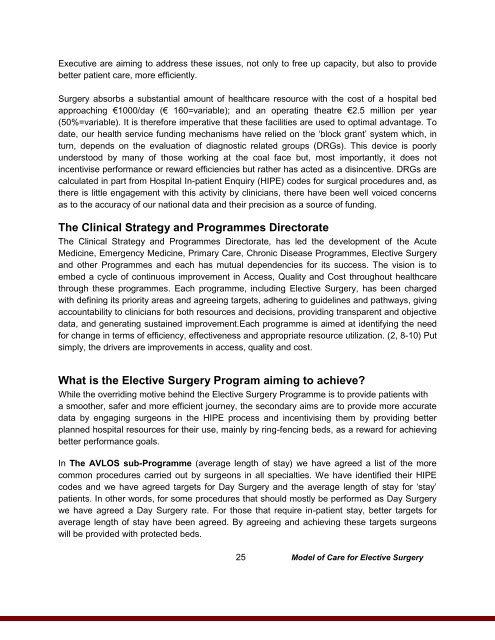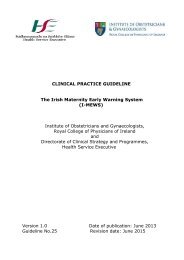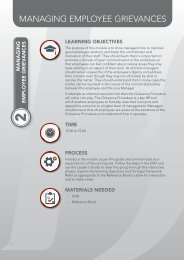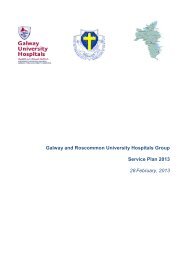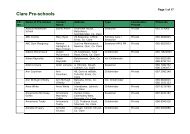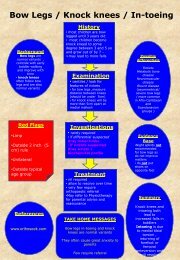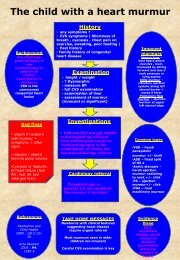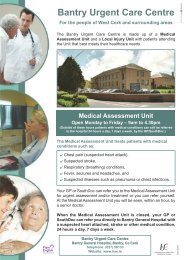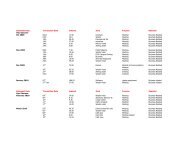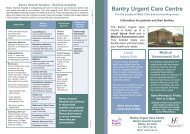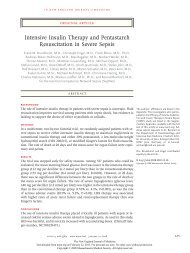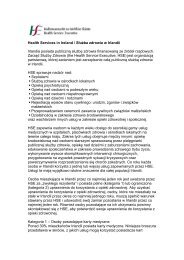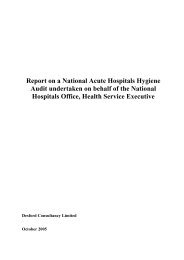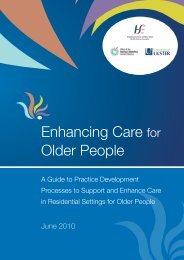Elective Surgery Programme Implementation Support Guide
Elective Surgery Programme Implementation Support Guide
Elective Surgery Programme Implementation Support Guide
You also want an ePaper? Increase the reach of your titles
YUMPU automatically turns print PDFs into web optimized ePapers that Google loves.
Executive are aiming to address these issues, not only to free up capacity, but also to provide<br />
better patient care, more efficiently.<br />
<strong>Surgery</strong> absorbs a substantial amount of healthcare resource with the cost of a hospital bed<br />
approaching €1000/day (€ 160=variable); and an operating theatre €2.5 million per year<br />
(50%=variable). It is therefore imperative that these facilities are used to optimal advantage. To<br />
date, our health service funding mechanisms have relied on the „block grant‟ system which, in<br />
turn, depends on the evaluation of diagnostic related groups (DRGs). This device is poorly<br />
understood by many of those working at the coal face but, most importantly, it does not<br />
incentivise performance or reward efficiencies but rather has acted as a disincentive. DRGs are<br />
calculated in part from Hospital In-patient Enquiry (HIPE) codes for surgical procedures and, as<br />
there is little engagement with this activity by clinicians, there have been well voiced concerns<br />
as to the accuracy of our national data and their precision as a source of funding.<br />
The Clinical Strategy and <strong>Programme</strong>s Directorate<br />
The Clinical Strategy and <strong>Programme</strong>s Directorate, has led the development of the Acute<br />
Medicine, Emergency Medicine, Primary Care, Chronic Disease <strong>Programme</strong>s, <strong>Elective</strong> <strong>Surgery</strong><br />
and other <strong>Programme</strong>s and each has mutual dependencies for its success. The vision is to<br />
embed a cycle of continuous improvement in Access, Quality and Cost throughout healthcare<br />
through these programmes. Each programme, including <strong>Elective</strong> <strong>Surgery</strong>, has been charged<br />
with defining its priority areas and agreeing targets, adhering to guidelines and pathways, giving<br />
accountability to clinicians for both resources and decisions, providing transparent and objective<br />
data, and generating sustained improvement.Each programme is aimed at identifying the need<br />
for change in terms of efficiency, effectiveness and appropriate resource utilization. (2, 8-10) Put<br />
simply, the drivers are improvements in access, quality and cost.<br />
What is the <strong>Elective</strong> <strong>Surgery</strong> Program aiming to achieve?<br />
While the overriding motive behind the <strong>Elective</strong> <strong>Surgery</strong> <strong>Programme</strong> is to provide patients with<br />
a smoother, safer and more efficient journey, the secondary aims are to provide more accurate<br />
data by engaging surgeons in the HIPE process and incentivising them by providing better<br />
planned hospital resources for their use, mainly by ring-fencing beds, as a reward for achieving<br />
better performance goals.<br />
In The AVLOS sub-<strong>Programme</strong> (average length of stay) we have agreed a list of the more<br />
common procedures carried out by surgeons in all specialties. We have identified their HIPE<br />
codes and we have agreed targets for Day <strong>Surgery</strong> and the average length of stay for „stay‟<br />
patients. In other words, for some procedures that should mostly be performed as Day <strong>Surgery</strong><br />
we have agreed a Day <strong>Surgery</strong> rate. For those that require in-patient stay, better targets for<br />
average length of stay have been agreed. By agreeing and achieving these targets surgeons<br />
will be provided with protected beds.<br />
25 Model of Care for <strong>Elective</strong> <strong>Surgery</strong>


